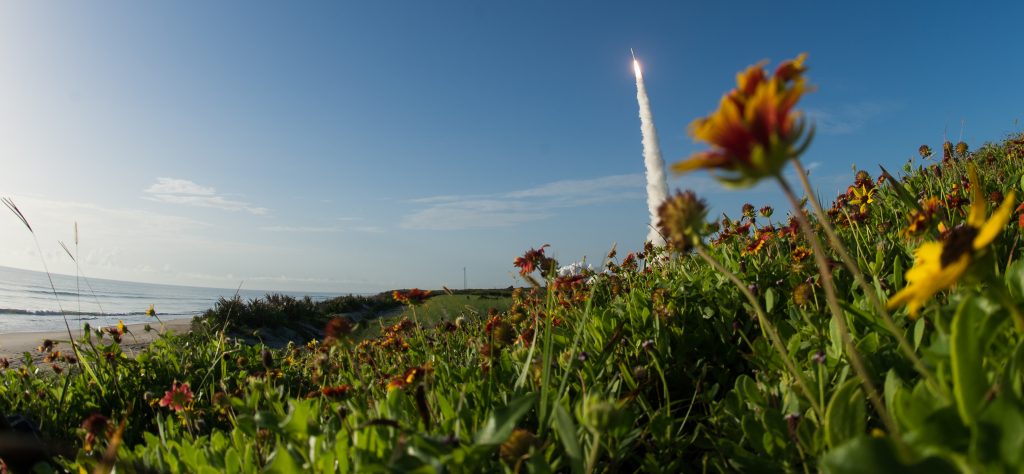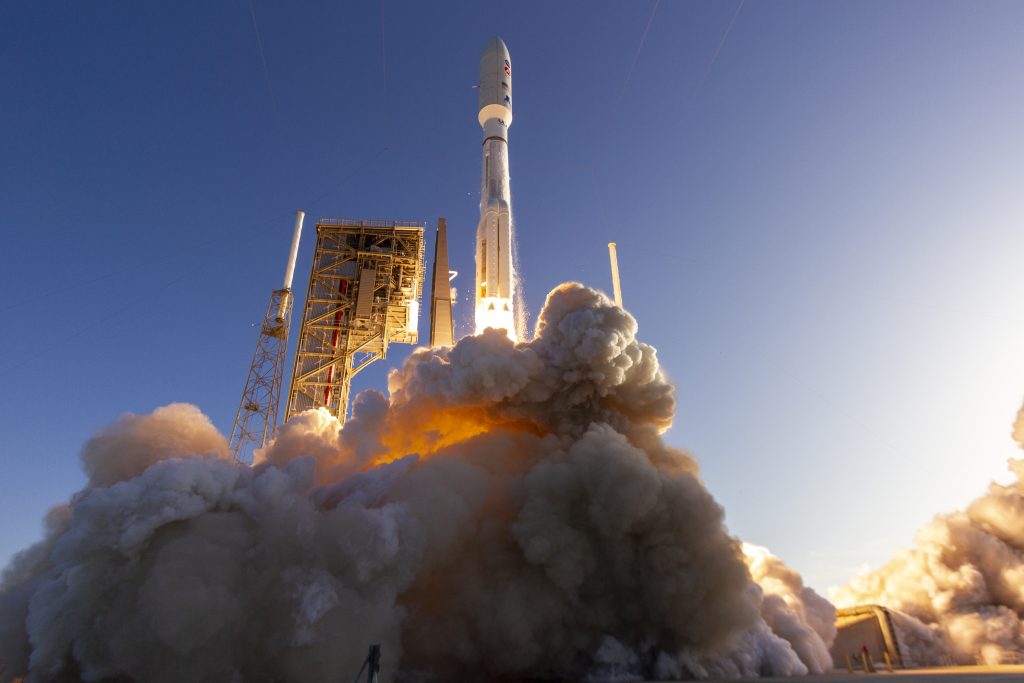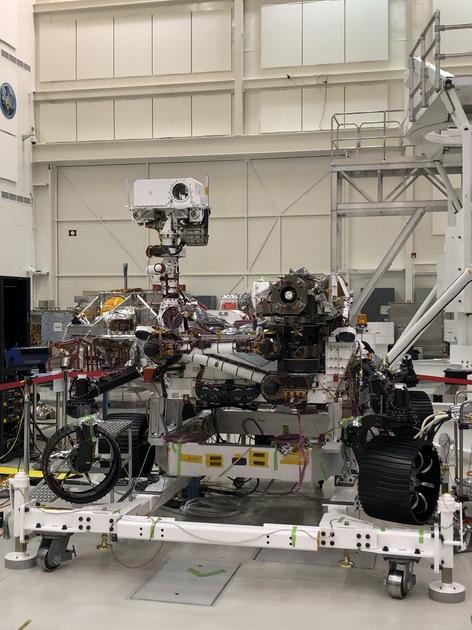July 31, 2020
Perseverance Has Reached the Stars, Seven Months Until it Hits Mars

By: burgundy bug
A United Launch Alliance Atlas V rocket with NASA’s Mars 2020 Perseverance rover onboard launches from Space Launch Complex 41, Thursday, July 30, 2020, at Cape Canaveral Air Force Station in Florida.
Source: Leaving Green Fields for the Red Planet | NASA Mars Exploration Program
Photo Credit: NASA/Joel Kowsky
Amidst a swirl of news about The Pentagon’s intent to release more UFO footage, NASA has taken off on a new era of space exploration with the Mars Perseverance launch yesterday morning.
Mars Perseverance blasted off along with NASA’s Ingenuity Mars Helicopter aboard the Atlas V-541 rocket from Launch Complex 41 at Cape Canaveral Air Force Station, Fla at 7:50 a.m. (EDT). The two are expected to arrive on Mars’ Jezero Crater around Feb. 18, 2021.
According to a recent NASA press release, they’ve selected Jezero Crater for the landing site because scientists believe it was once home to an ancient river delta over 3.5 billion years ago.
Perseverance and Ingenuity aren’t the only ones headed towards the Red Planet, either. Just last week, China and the United Arab Emirates launched their first Mars Rovers, too.
? We have LIFTOFF to Mars! The @ulalaunch Atlas V takes flight with our @NASAPersevere rover. The #CountdownToMars continues as Perseverance begins her 7-month journey to the Red Planet! pic.twitter.com/3RTL1CR4WS
— NASA (@NASA) July 30, 2020
“Jezero Crater is the perfect place to search for signs of ancient life,” said Thomas Zurbuchen, associate administrator for NASA’s Science Mission Directorate at the agency’s headquarters in Washington. “Perseverance is going to make discoveries that cause us to rethink our questions about what Mars was like and how we understand it today.”
“As our instruments investigate rocks along an ancient lake bottom and select samples to return to Earth, we may very well be reaching back in time to get the information scientists need to say that life has existed elsewhere in the universe.”
THOMAS ZURBUCHEN, ASSOCIATE ADMINISTRATOR FOR NASA’S SCIENCE MISSION DIRECTORATE AT THE AGENCY’S HEADQUARTERS IN WASHINGTON
Why Are We Sending New Tech to Mars?
A United Launch Alliance (ULA) Atlas V rocket carrying the Mars 2020 mission with the Perseverance rover lifts off from Space Launch Complex-41 at 7:50 a.m. EDT on July 30, 2020.
Source: Powerful Launch for Mars 2020 Perseverance | NASA Mars Exploration Program
Photo credit: United Launch Alliance
Perseverance is designed to aid it’s older robo-sibling — Mars Curiosity — on its search for signs of past microbial life on Mars.
Meanwhile, Ingenuity will embark on the first-ever controlled flight test on another planet.
Mars Curiosity v.s. Mars Perseverance
Mars Curiosity v.s. Mars Perseverance
Source: NASA Mars Rover Curiosity at JPL, Side View & Mars 2020 Rover on Stand | NASA Images and NASA Mars Exploration Program
Photo credit: NASA/JPL-Caltech and NASA/JPL-Caltech/LESIA
Mars Curiosity launched on Nov. 26, 2011 and arrived on the Red Planet on Aug. 5, 2012.
“Curiosity set out to answer the question: Did Mars ever have the right environmental conditions to support small life forms called microbes,” NASA says. “Early in its mission, Curiosity’s scientific tools found chemical and mineral evidence of past habitable environments on Mars. It continues to explore the rock record from a time when Mars could have been home to microbial life.”
Some of Curiosity’s historic accomplishments include:
- Sending the first selfies from the surface of Mars
- Demonstrating the ability to land a large, heavy rover on Mars
- Demonstrating long-range mobility on Mars for studying diverse environments and analyzing samples found around the planet
Source: Hello, Gorgeous! | NASA’s Curiosity Mars Rover
Over the last eight years, Curiosity has captured over 700,000 photographs.
“The Perseverance rover relies on the successful design of the Mars Science Laboratory rover, Curiosity,” NASA explains. “However, Perseverance has a new science and technology toolbox.”
The ability to collect and store samples on the surface of Mars is one of the new key features of Perseverance. It collects samples with an upgraded coring drill, then stores them in tubes on the surface of the planet.
“In the future, another space mission could potentially pick up the samples and bring them to Earth for detailed analysis,” NASA says.
While Perseverance collects rock cores and caches them for future analysis, Curiosity performed onsite analysis of samples using its built-in laboratory.
In addition to its larger “hand,” Perseverance has a color camera for “close-up surface inspection and ‘selfies’ for engineering health checkups,” NASA says.
That’s right — get ready for more robot selfies taken over 60 million miles away.

Perseverance has upgraded software that NASA intends to continue updating throughout the mission, too. The rover operates more efficiently than it’s predecessors. This gives it the “brains” to conduct onsite analysis and store the samples without having to consult Earth-bound engineers as frequently.
“Also, engineers have added a ‘simple planner’ to the flight software,” NASA adds. “This allows more effective and autonomous use of electrical power and other rover resources. It allows the rover to shift the time of some activities to take advantage of openings in the daily operations schedule.”
The wheels are designed to resist more wear and tear on the surface of Mars, as well. Perseverance’s wheels are narrower than Curiosity’s, but larger in diameter and made of thicker aluminum.
What’s with the Helicopter Though?
NASA’s Ingenuity Mars Helicopter
Source: NASA’s Ingenuity Mars Helicopter: Attempting the First Powered Flight on Mars | NASA Jet Propulsion Laboratory
While satellites have orbited Mars and rovers have explored its surface, there have never been any attempts to fly on Mars… Until now.
Ingenuity is the first aircraft designed to fly on another planet. If successful, this could open up opportunities to explore Mars from another perspective.
“It’s extremely difficult to fly on Mars because the atmosphere is so thin compared to Earth’s,” explained NASA Jet Propulsion Laboratory project manager MiMi Aung. “The first challenge is to make a vehicle that’s light enough to be lifted. The second is to generate lift, the rotor system needs to spin very fast.”
The rotors are spinning between 2,000 and 3,000 revolutions per minute, which takes great deal of energy.
“It’s that balance of a very light system yet having enough energy that’s needed to spin the rotor so fast to lift,” Aung continued. “And on top of it, having to design in the autonomy.”
For context, a car engine typically idles at about 600 to 800 rpm and weighs about 300 lbs. Ingenuity must operate at a rate roughly three times higher than that at a weight of 4 lbs (1.5 lbs on Mars).
“Most of the flights will be at the three to five meter height,” said Mars Helicopter chief engineer Bob Balaram. “We will be flying horizontally again at a few meters per second, probably go out 50 to 70 meters and come back.”
While the test flight is Ingenuity’s main objective, Balaram says they may return a few images from the mission “because they always look cool.”
Although the Ingenuity engineers have extensively tested the helicopter, the team still acknowledges that it’s still a high-risk mission.
“What’s really most important is everything we’re learning here is for the future rotorcraft systems we want to introduce into space exploration,” Aung said.
Is There Anything Else Headed Towards Mars?
Yes. China began its first mission on Mars with the launch of Tianwen-1 on July 23.
“The main task of Tianwen-1 is to perform a global and extensive survey of the entire planet using the orbiter, and to send the rover to surface locations of scientific interests to conduct detailed investigations with high accuracy and resolution,” says a Nature Astronomy Journal paper published in mid-July.
To narrow it down a bit, Tianwen-1 will:
- Map the form and geologic structure of Mars
- Investigate soil characteristics and distribution of water/ice
- Analize surface material composition
- Measure the ionosphere, climate, and environment of Mars’ surface
- Perceive physical fields and internal structures of Mars
The United Arab Emirates has also launched its first Mars expedition with the Hope Probe on July 20.
“EMM is designed to orbit Mars and study the dynamics in the Martian atmosphere on a global scale, and on both diurnal and seasonal timescales,” says the UAE Space Agency. “Using three scientific instruments on board of the spacecraft, EMM will provide a set of measurements fundamental to an improved understanding of circulation and weather in the Martian lower and middle atmosphere.”
The Emirates Mars Mission seeks to uncover the science behind upward transport of energy and particles on Mars, as well as the “escape of atmospheric particles from the gravity of Mars.”
What About Those UFOs Though
CNN reporting on the UFO encounters. Published July 30, 2020.
Source: New details of UFO encounters to be released to public | CNN
After releasing three videos of U.S. Navy pilots spotting UFOs in 2004 and 2015, The Pentagon has announced they will soon release more information about these encounters.
…That’s all we know so far. Keep your tinfoil hats and popcorns on standby for the time being.
Interested in having content featured in an upcoming blog post or issue of The Burgundy Zine? Head on over to the submissions page!
For all other inquiries, please fulfill a contact form.





